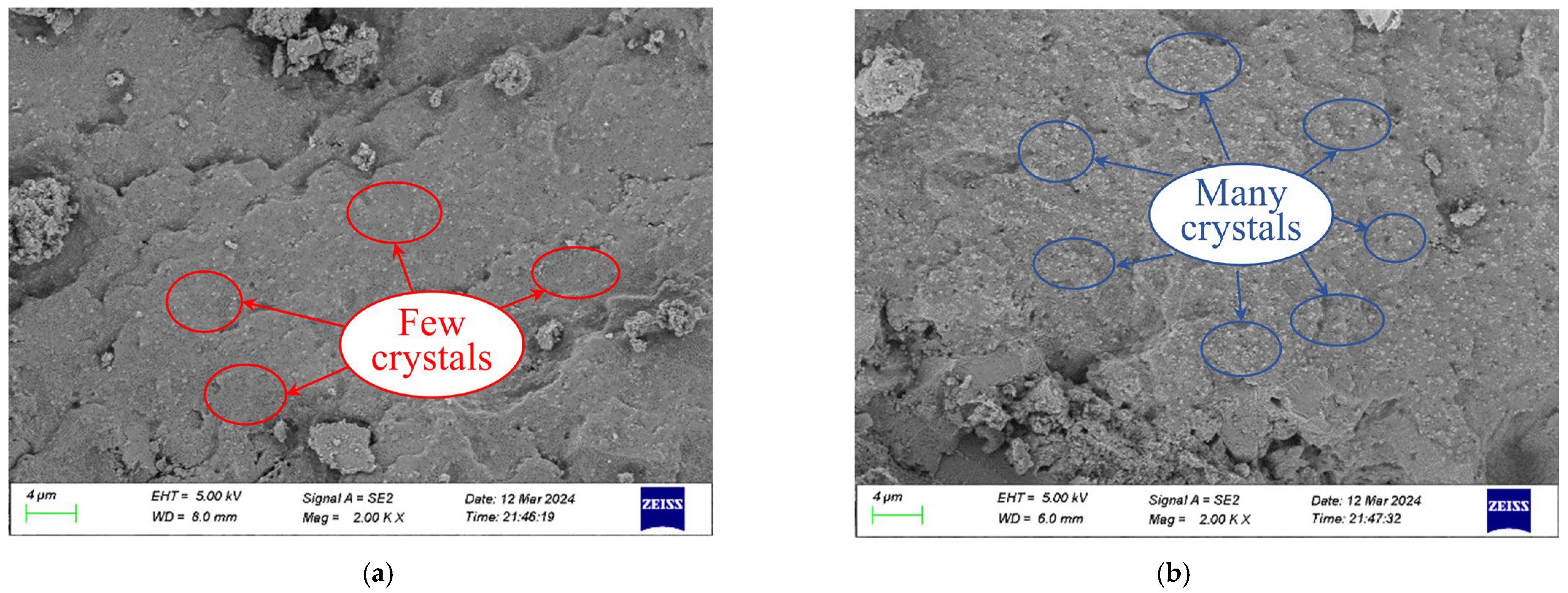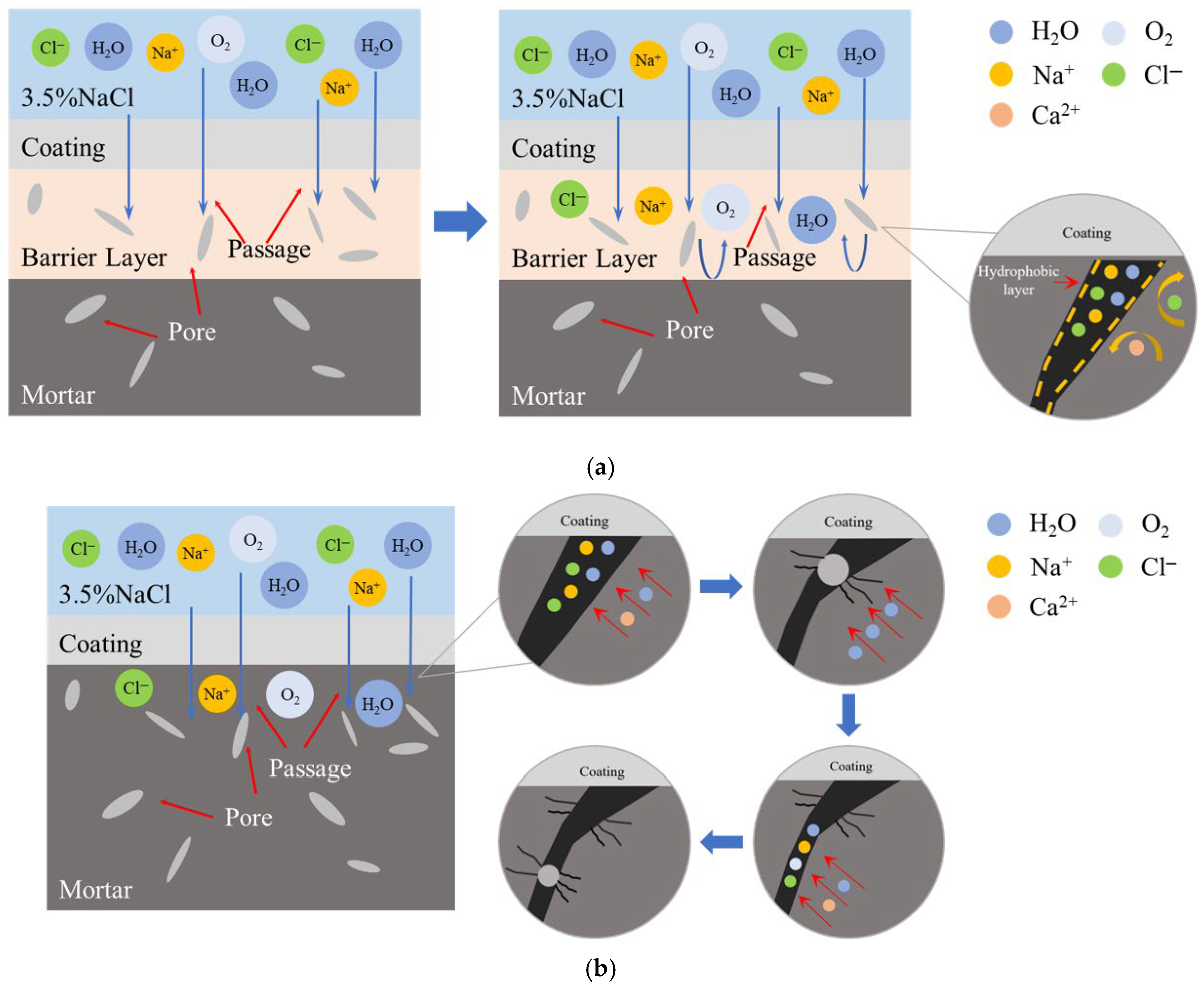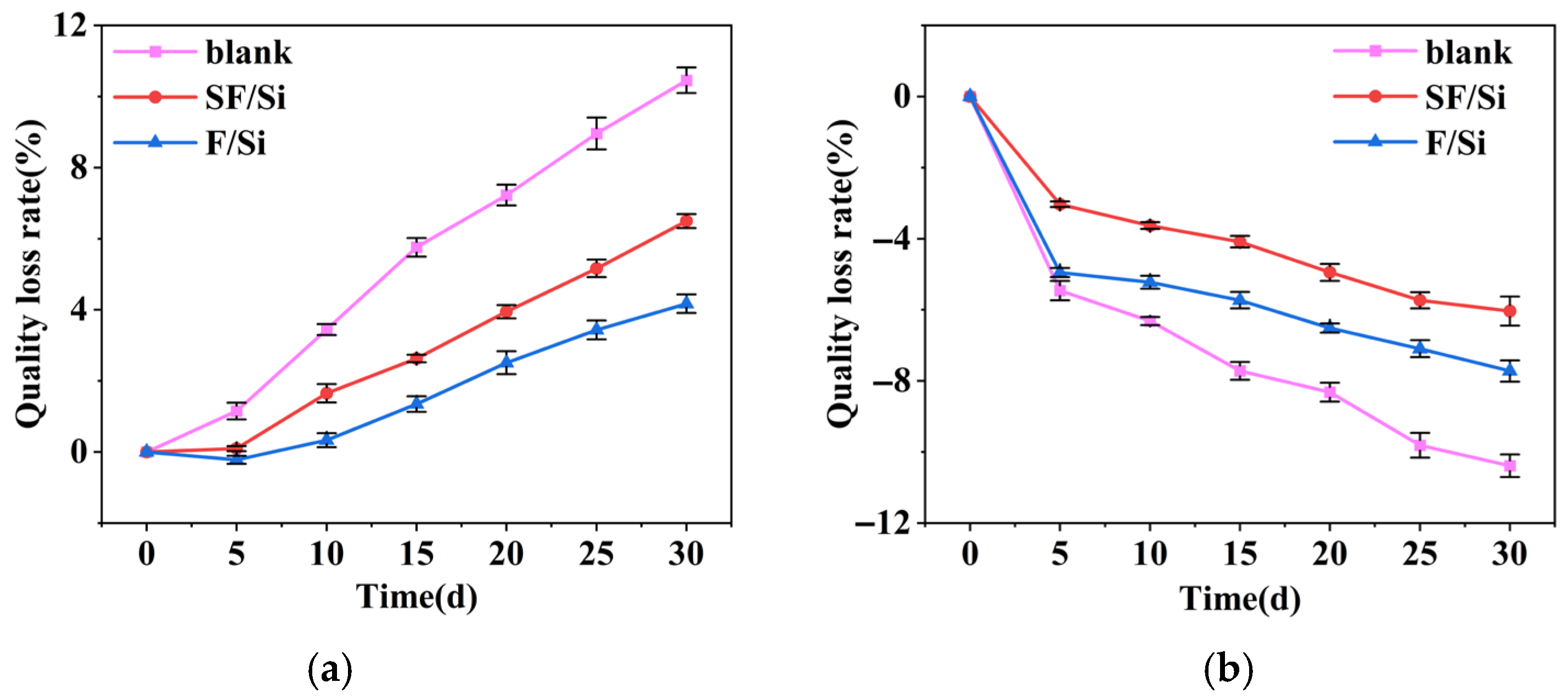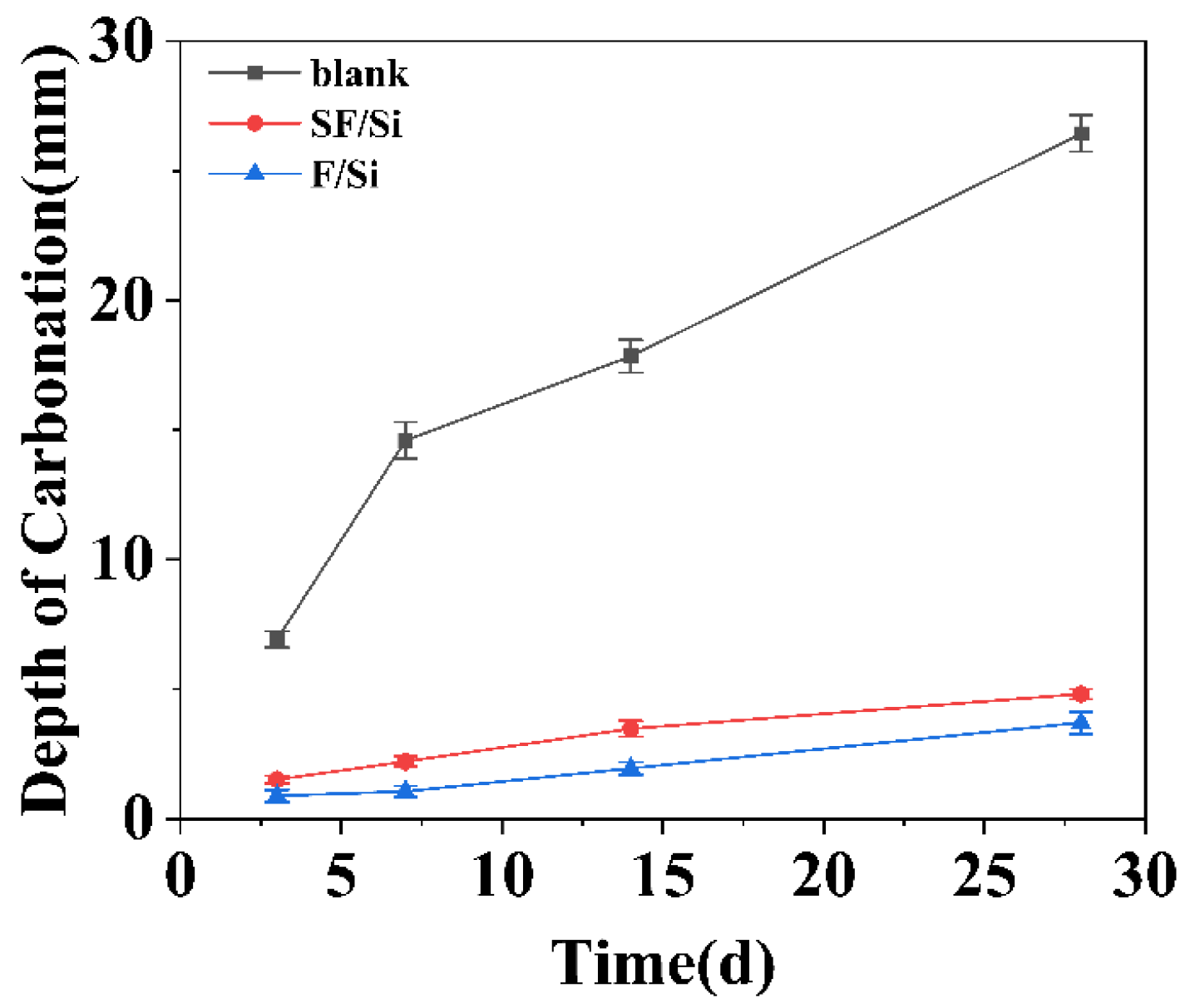Polymer–Silicate Composite Gel Systems for Enhanced Chloride Resistance of Cement-Based Materials
Abstract
1. Introduction
2. Results and Discussion
2.1. Chloride Ion Migration Coefficient
2.2. Chloride Ion Content Distribution
2.3. Mass Loss Under Acid and Alkali Corrosion
2.4. Compressive Strength Loss Under Acid and Alkali Corrosion
2.5. Carbonation Depth
2.6. Comprehensive Performance Comparison and Analysis
| Ref. | Coating Type | Test Method | Control/Coating (10−12 m2/s) | Reduction Rate (%) | Protective System Type |
|---|---|---|---|---|---|
| (SF/Si) | Fluorocarbon/Silane | RCM | 41.1/4.9 | 88.1 | inorganic-modified organic composite system |
| (F/Si) | Fluorocarbon | RCM | 41.1/13.6 | 67.1 | Organic system |
| [50] | Polyurethane | FT | 9.0/4.7 | 47.8 | Organic system |
| [51] | Acrylic | RCMT | 14.4/6.53 | 54.7 | Organic system |
| [52] | Nano-SiO2 modified silane | RCPT | 20.93/3.29 | 84.3 | Inorganic-modified system |
| Ref. | Coating Type | 28d Carbonation Depth (mm) | Reduction Rate (%) | Protective System Type |
|---|---|---|---|---|
| (SF/Si) | Fluorocarbon/Silane | 26.44/4.82 | 81.8 | inorganic-modified organic composite system |
| (F/Si) | Fluorocarbon | 26.44/3.71 | 86.0 | Organic system |
| [53] | Acrylic | 10.2/2.98 | 70.8 | Organic system |
| [55] | Pure silane | 23.6/20.4 | 13.6 | Inorganic system |
| [54] | Nano-SiO2 modified Polyurethane | 5.8/2.0 | 65.5 | Organic-modified system |
3. Conclusions
- The RCM test indicated that the SF/Si composite gel system had a chloride penetration depth of only 14.9 mm, representing a 57% reduction compared to the F/Si gel system. Its DRCM value was 4.91 × 10−12 m2/s, 63.97% lower than F/Si, demonstrating a more effective limitation of chloride ion migration.
- Chloride natural diffusion tests demonstrated that after 14, 28, and 56 days of immersion, SF/Si contained less free chloride across the full depth compared to F/Si. Within the 0–5 mm range, SF/Si’s free chloride content was 0.121%, 0.225%, and 0.412%, corresponding to reductions of 55.35%, 50.10%, and 43.64% relative to F/Si. This indicates that the novel polymer–silicate composite gel system exhibits superior resistance to chloride penetration compared to the fluorocarbon–silicate gel system.
- SEM images revealed that SF/Si exhibited fewer surface NaCl crystal precipitations and a slower hydration reaction, suggesting enhanced hydrophobicity. This effectively restricted chloride transport, allowing SF/Si to resist chloride penetration more efficiently than F/Si.
- The incorporation of silane had minimal impact on the inherent acid and alkali resistance of the F/Si gel system, with SF/Si maintaining comparable performance to F/Si under acidic and alkaline conditions.
- The incorporation of silane components decreased the compactness of the coating, resulting in a carbonation resistance slightly lower than that of the pure fluorocarbon coating. Nevertheless, according to the JGJ/T193-2009 standard, the 28-day carbonation depth of SF/Si (4.82 mm) still corresponds to Class T-IV, indicating a satisfactory engineering performance.
4. Materials and Methods
4.1. Experimental Materials
4.2. Preparation of Mortar Specimens
4.3. Preparation of Test Materials
4.4. Test Method
4.4.1. RCM Test
4.4.2. Chloride Ion Natural Erosion Test
4.4.3. Acid and Alkali Corrosion Test
4.4.4. Carbonation Test
4.5. Statistical Analysis
- (1)
- Data presentation
- (2)
- Homogeneity of variance test
- (3)
- Significance tests
- (4)
- Significance level
Supplementary Materials
Author Contributions
Funding
Institutional Review Board Statement
Informed Consent Statement
Data Availability Statement
Conflicts of Interest
References
- Fenaux, M.; Reyes, E.; Galvez, J.C.; Moragues, A. Modelling the transport of chloride and other ions in cement-based materials. Cem. Concr. Compos. 2019, 97, 33–42. [Google Scholar] [CrossRef]
- Qu, F.; Li, W.; Dong, W.; Tam, V.W.Y.; Yu, T. Durability deterioration of concrete under marine environment from material to structure: A critical review. J. Build. Eng. 2021, 35, 102074. [Google Scholar] [CrossRef]
- Liao, J.; Wang, Y.; Wang, Y.; Lai, X. Preparation and evaluation of TA/APTES-HDTMS hydrophobic nanocomposite coating for enhancing corrosion resistance of concrete. Constr. Build. Mater. 2023, 408, 133792. [Google Scholar] [CrossRef]
- Glasser, F.P.; Marchand, J.; Samson, E. Durability of concrete—Degradation phenomena involving detrimental chemical reactions. Cem. Concr. Res. 2008, 38, 226–246. [Google Scholar] [CrossRef]
- Michel, A.; Otieno, M.; Stang, H.; Geiker, M.R. Propagation of steel corrosion in concrete: Experimental and numerical investigations. Cem. Concr. Compos. 2016, 70, 171–182. [Google Scholar] [CrossRef]
- Peng, J.; Hu, S.; Zhang, J.; Cai, C.S.; Li, L. Influence of cracks on chloride diffusivity in concrete: A five-phase mesoscale model approach. Constr. Build. Mater. 2019, 197, 587–596. [Google Scholar] [CrossRef]
- Rodrigues, R.; Gaboreau, S.; Gance, J.; Ignatiadis, I.; Betelu, S. Reinforced concrete structures: A review of corrosion mechanisms and advances in electrical methods for corrosion monitoring. Constr. Build. Mater. 2021, 269, 121240. [Google Scholar] [CrossRef]
- Zhang, A.; Wang, Y.; Wang, H. Preparation of inorganic-polymer nano-emulsion inhibitor for corrosion resistance of steel reinforcement for concrete. Alex. Eng. J. 2023, 66, 537–542. [Google Scholar] [CrossRef]
- Guo, S.-Y.; Luo, H.-H.; Tan, Z.; Chen, J.-Z.; Zhang, L.; Ren, J. Impermeability and interfacial bonding strength of TiO2-graphene modified epoxy resin coated OPC concrete. Prog. Org. Coat. 2021, 151, 106029. [Google Scholar] [CrossRef]
- Dorado, F.; Toledo, L.; de la Osa, A.R.; Esteban-Arranz, A.; Sacristan, J.; Pellegrin, B.; Steck, J.; Sanchez-Silva, L. Adhesion enhancement and protection of concrete against aggressive environment using graphite-Fe2O3 modified epoxy coating. Constr. Build. Mater. 2023, 379, 131179. [Google Scholar] [CrossRef]
- Duan, Y.; Zhao, Y.; Liu, J.; Chen, B.; Zhao, Q.; Li, J.; Sun, Y.; Ma, X. Preparation of Fluorine—Containing Acrylate Coatings and Its Application in Concrete Protection. Paint Coat. Ind. 2016, 46, 72–77. [Google Scholar]
- Sassani, A.; Arabzadeh, A.; Ceylan, H.; Kim, S.; Gopalakrishnan, K.; Taylor, P.C.; Nahvi, A. Polyurethane-carbon microfiber composite coating for electrical heating of concrete pavement surfaces. Heliyon 2019, 5, e02359. [Google Scholar] [CrossRef] [PubMed]
- Ajir, K.; Toufigh, V.; Ghaemian, M. Protecting ordinary cement concrete against acidic and alkaline attacks utilizing epoxy resin coating. Constr. Build. Mater. 2025, 472, 141003. [Google Scholar] [CrossRef]
- Vipulanandan, C.; Parihar, A.; Issac, M. Testing and Modeling Composite Coatings with Silanes for Protecting Reinforced Concrete in Saltwater Environment. J. Mater. Civ. Eng. 2011, 23, 1602–1608. [Google Scholar] [CrossRef]
- Pan, X.; Shi, Z.; Shi, C.; Ling, T.-C.; Li, N. A review on surface treatment for concrete—Part 2: Performance. Constr. Build. Mater. 2017, 133, 81–90. [Google Scholar] [CrossRef]
- Almusallam, A.; Khan, F.; Dulaijan, S.; Al-Amoudi, O. Effectiveness of surface coatings in improving concrete durability. Cem. Concr. Compos. 2003, 25, 473–481. [Google Scholar] [CrossRef]
- Vipulanandan, C.; Liu, J. Performance of polyurethane-coated concrete in sewer environment. Cem. Concr. Res. 2005, 35, 1754–1763. [Google Scholar] [CrossRef]
- Merah, A.; Khenfer, M.M.; Korichi, Y. The effect of industrial coating type acrylic and epoxy resins on the durability of concrete subjected to accelerated carbonation. J. Adhes. Sci. Technol. 2015, 29, 2446–2460. [Google Scholar] [CrossRef]
- Zheng, Y.; Mao, Q.J.; Wang, Y.L.; Wang, Z.M.; Cui, S.P. Study on the influence of painting processes on the protective property of concrete coating. In Proceedings of the 3rd Mainland, Taiwan and Hong Kong Conference on Green Building Materials, Wuhan, China, 25–27 November 2011; pp. 88–92. [Google Scholar]
- Li, G.; Hu, W.; Cui, H.; Zhou, J. Long-term effectiveness of carbonation resistance of concrete treated with nano-SiO2 modified polymer coatings. Constr. Build. Mater. 2019, 201, 623–630. [Google Scholar] [CrossRef]
- Hong, Z.; Jiang, H.; Xue, M.; Ke, C.; Luo, Y.; Yin, Z.; Xie, C.; Zhang, F.; Xing, Y. SiC-enhanced polyurethane composite coatings with excellent anti-fouling, mechanical, thermal, chemical properties on various substrates. Prog. Org. Coat. 2022, 168, 106909. [Google Scholar] [CrossRef]
- Li, W.; Liao, X.; Ji, T.; Wu, S. Effects of Fluorocarbon Coating on Resistance to Chloride Ion Penetration of Concrete in Marine Environment. Surf. Technol. 2017, 46, 43–47. [Google Scholar] [CrossRef]
- Pan, Y.; Zhou, R.; Zhu, X.; Zhao, B.; Li, W. Development of Elastic Fluorocarbon Coatings for Concrete Structures in Marine Environment. Paint Coat. Ind. 2019, 49, 27–32. [Google Scholar] [CrossRef]
- Cai, Y.; Hou, P.; Duan, C.; Zhang, R.; Zhou, Z.; Cheng, X.; Shah, S. The use of tetraethyl orthosilicate silane (TEOS) for surface-treatment of hardened cement-based materials: A comparison study with normal treatment agents. Constr. Build. Mater. 2016, 117, 144–151. [Google Scholar] [CrossRef]
- Moradllo, M.K.; Sudbrink, B.; Ley, M.T. Determining the effective service life of silane treatments in concrete bridge decks. Constr. Build. Mater. 2016, 116, 121–127. [Google Scholar] [CrossRef]
- Sudbrink, B.; Moradllo, M.K.; Hu, Q.; Ley, M.T.; Davis, J.M.; Materer, N.; Apblett, A. Imaging the presence of silane coatings in concrete with micro X-ray fluorescence. Cem. Concr. Res. 2017, 92, 121–127. [Google Scholar] [CrossRef]
- Hou, D.; Wu, C.; Yin, B.; Hua, X.; Xu, H.; Wang, X.; Li, S.; Zhou, Y.; Jin, Z.; Xu, W.; et al. Investigation of composite silane emulsion modified by in-situ functionalized graphene oxide for cement-based materials. Constr. Build. Mater. 2021, 304, 124662. [Google Scholar] [CrossRef]
- Jiang, J.; Li, S.; Shen, J.; Hu, J.; Geng, Y.; Hou, D.; Wang, M.; Yuan, M.; Shi, J. Microscopic mechanism of corrosion inhibition in cementitious materials by silane coatings in sulfuric acid: Experimental and theoretical insights. Constr. Build. Mater. 2025, 471, 140751. [Google Scholar] [CrossRef]
- Zhu, Y.; Chen, Y.; Gan, W. Effects of organism silanes on anti-corrosion properties of high-performance marine concrete. Concrete 2007, 30, 77–80. [Google Scholar]
- Li, S.; Zhang, W.; Liu, J.; Hou, D.; Geng, Y.; Chen, X.; Gao, Y.; Jin, Z.; Yin, B. Protective Mechanism of Silane on Concrete upon Marine Exposure. Coatings 2019, 9, 558. [Google Scholar] [CrossRef]
- Aguiar, J.B.; Junior, C. Carbonation of surface protected concrete. Constr. Build. Mater. 2013, 49, 478–483. [Google Scholar] [CrossRef]
- Szubert, K.; Wojciechowski, J.; Karasiewicz, J.; Maciejewski, H.; Lota, G. Corrosion-protective coatings based on fluorocarbosilane. Prog. Org. Coat. 2018, 123, 374–383. [Google Scholar] [CrossRef]
- Gonzalez-Coneo, J.; Zarzuela, R.; Luna, M.; Mosquera, M. Water-soluble fluorosilane supplemented with fumed silica as admixture for producing hydrophobic concrete: Effects on cement hydration, mechanical properties and water protection properties. Dev. Built Environ. 2024, 17, 100317. [Google Scholar] [CrossRef]
- Szubert, K.; Dutkiewicz, A.; Nowicki, M.; Maciejewski, H. Fluorocarbosilane-Based Protective Coatings for Concrete. Materials 2022, 15, 5994. [Google Scholar] [CrossRef] [PubMed]
- Boutamart, M.; Rafqah, S.; Hadri, A.; Nouneh, K.; Zaidi, S.; Bichara, H.; Briche, S. Design of fluorine-free superhydrophobic coating for fibred architectonic concrete. Constr. Build. Mater. 2024, 425, 136086. [Google Scholar] [CrossRef]
- Ibrahim, A.; Bassuoni, M.; Carroll, J.; Ghazy, A. Performance of concrete superficially treated with nano-modified coatings under sulfuric acid exposures. J. Build. Eng. 2024, 86, 108957. [Google Scholar] [CrossRef]
- Huang, H.; Fang, S.; Luo, S.; Hu, J.; Yin, S.; Wei, J.; Yu, Q. Multiscale modification on acrylic resin coating for concrete with silicon/fluorine and graphene oxide (GO) nanosheets. Constr. Build. Mater. 2021, 305, 124297. [Google Scholar] [CrossRef]
- Pramualkijja, W.; Jiratumnukul, N. The preparation of hydrophobic hybrid film coatings from siloxane-modified polyacrylate associated with nano-fumed silica and organo-modified clay. J. Coat. Technol. Res. 2022, 19, 1467–1492. [Google Scholar] [CrossRef]
- Tian, J.; Li, Y.; Yang, G.; Su, M.; Yang, Z. Silane-nanoSiO2 composite surface modification of steel fibres: A multiscale experimental study of fibre-UHPC interfaces. Compos. Part B Eng. 2026, 308, 112999. [Google Scholar] [CrossRef]
- Liu, W.; Song, J.; Zhao, H.; Cui, Z.; Zhang, S.; Qiao, Y.; Cao, C.; Li, W. Mechanically stable and superhydrophobic nano-SiO2@silane/silicate coating for enhanced impermeability of mortar. Constr. Build. Mater. 2025, 470, 140541. [Google Scholar] [CrossRef]
- Ji, Y.; Wendt, K.; Pel, L.; Stephan, D. Insights into Cl-binding and phase evolution during the early hydration of cement pastes prepared with NaCl solutions: A study using high-field NMR and in situ XRD. Cem. Concr. Compos. 2025, 164, 106266. [Google Scholar] [CrossRef]
- Pramanik, S.; Bhuiyan, M.; Robert, D.; Roychand, R.; Gao, L.; Cole, I.; Pramanik, B. Functional Polymer-Clay Composite Coating for Corrosion Protection in Concrete Sewer Structures. ACS Appl. Eng. Mater. 2025, 3, 2979–2994. [Google Scholar] [CrossRef]
- Liu, J.; Wu, L.; Zhu, J.; Jia, H.; Liu, L.; Zhang, S.; Yang, C.; Chen, Z.; Shi, C. Effect of silica fume on corrosion resistance of cement-based materials under carbonic acid water environment. Cem. Concr. Compos. 2025, 157, 105949. [Google Scholar] [CrossRef]
- Zheng, Y.; Zhong, H.; Sun, K.; Shen, B.; Cui, K.; Zhao, Y.; Xiong, G.; Qin, Q. Effect of composite activator on hydration kinetics and micromechanical properties of alkali-activated slag. Cem. Concr. Compos. 2025, 160, 106047. [Google Scholar] [CrossRef]
- Leemann, A. Alkali-silica reaction—The mechanism leading to concrete deterioration. Can. J. Civ. Eng. 2025, 52, 1615–1629. [Google Scholar] [CrossRef]
- Thissen, P.; Bogner, A.; Dehn, F. Surface treatments on concrete: An overview on organic, inorganic and nano-based coatings and an outlook about surface modification by rare-earth oxides. RSC Sustain. 2024, 2, 2092–2124. [Google Scholar] [CrossRef]
- Nguyen, M.; Nakarai, K. An enhanced air permeability model based on stable moisture conditions for nondestructive durability assessment. Mater. Struct. 2025, 58, 164. [Google Scholar] [CrossRef]
- Mottl, M.; Pazderka, J.; Reiterman, P. Crystalline Coating and Its Influence on Chloride Ion Diffusion Resistance of Carbonated Concrete. Coatings 2025, 15, 163. [Google Scholar] [CrossRef]
- JGJ/T193-2009; Standard for Inspection and Assessment of Concrete Durability. Ministry of Housing and Urban-Rural Development of the People’s Republic of China: Beijing, China, 2009.
- Zhang, J.-Z.; Buenfeld, N. Chloride profiles in surface-treated mortar specimens. Constr. Build. Mater. 2000, 14, 359–364. [Google Scholar] [CrossRef]
- Aguiar, J.; Camoes, A.; Moreira, P. Coatings for concrete protection against aggressive environments. J. Adv. Concr. Technol. 2008, 6, 243–250. [Google Scholar] [CrossRef]
- Schueremans, L.; Van Gemert, D.; Giessler, S. Chloride penetration in RC-structures in marine environment—Long term assessment of a preventive hydrophobic treatment. Constr. Build. Mater. 2007, 21, 1238–1249. [Google Scholar] [CrossRef]
- Lo, T.; Liao, W.; Wong, C.; Tang, W. Evaluation of carbonation resistance of paint coated concrete for buildings. Constr. Build. Mater. 2016, 107, 299–306. [Google Scholar] [CrossRef]
- Qu, H.; Feng, M.; Li, M.; Tian, D.; Zhang, Y.; Chen, X.; Li, G. Enhancing the carbonation and chloride resistance of concrete by nano-modified eco-friendly water-based organic coatings. Mater. Today Commun. 2023, 37, 107284. [Google Scholar] [CrossRef]
- Ibrahim, M.; Al-Gahtani, A.; Maslehuddin, M.; Dakhil, F. Use of surface treatment materials to improve concrete durability. J. Mater. Civ. Eng. 1999, 11, 36–40. [Google Scholar] [CrossRef]
- GB/T 17671-2021; Test Method of Cement Mortar Strength (ISO Method). National Standardizationc Administration: Beijing, China, 2021.
- GB/T 50082-2009; Standard for Test Methods of Long-Term Performance and Durability of Ordinary Concrete. Ministry of Housing and Urban-Rural Development of the People’s Republic of China: Beijing, China, 2009.
- JGJT70-2009; Standard for Test Method of Basic Properties of Construction Mortar. Ministry of Housing and Urban-Rural Development of the People’s Republic of China: Beijing, China, 2009.












| Systems Type | Depth of Penetration (mm) | DRCM (10−12 m2/s) | DRCM Decline Rate (%) |
|---|---|---|---|
| blank | 44.2 ± 1.1 | 41.1 ± 1.8 | -- |
| SF/Si | 14.8 ± 0.8 | 4.9 ± 0.2 | 88.1 |
| F/Si | 35.0 ± 1.5 | 13.6 ± 0.4 | 67.1 |
| Chloride Ion Radius | Calcium Ion Radius | Sodium Ion Radius | Carbonate Ion Radius | CaCO3 Unit Cell Parameters a | NaCl Unit Cell Parameters a |
|---|---|---|---|---|---|
| 181 | 100 | 102 | 178 | 499 | 564 |
| Grade | T-I | T-II | T-III | T-IV | T-V |
|---|---|---|---|---|---|
| Carbonation Depth d (mm) | d ≥ 30 | 20 ≤ d < 30 | 10 ≤ d < 20 | 0.1 ≤ d < 10 | d < 0.1 |
| Name | Dosage (g) | Mass Fraction (%) |
|---|---|---|
| Deionized water | 90 | 30 |
| Hydroxyethyl cellulose | 0.75 | 0.25 |
| Dispersant | 1.8 | 0.6 |
| pH adjuster | 0.45 | 0.15 |
| Wetting agent | 0.4 | 0.13 |
| Antifreeze agent | 3 | 1 |
| Titanium dioxide R-699 | 60 | 20 |
| Film-forming additive | 11 | 3.67 |
| Liquid Fluorocarbon | 135 | 45 |
Disclaimer/Publisher’s Note: The statements, opinions and data contained in all publications are solely those of the individual author(s) and contributor(s) and not of MDPI and/or the editor(s). MDPI and/or the editor(s) disclaim responsibility for any injury to people or property resulting from any ideas, methods, instructions or products referred to in the content. |
© 2025 by the authors. Licensee MDPI, Basel, Switzerland. This article is an open access article distributed under the terms and conditions of the Creative Commons Attribution (CC BY) license (https://creativecommons.org/licenses/by/4.0/).
Share and Cite
Zhang, T.; Dai, Y.; Ren, S.; Huang, Z.; Han, C.; Ding, W. Polymer–Silicate Composite Gel Systems for Enhanced Chloride Resistance of Cement-Based Materials. Gels 2025, 11, 936. https://doi.org/10.3390/gels11120936
Zhang T, Dai Y, Ren S, Huang Z, Han C, Ding W. Polymer–Silicate Composite Gel Systems for Enhanced Chloride Resistance of Cement-Based Materials. Gels. 2025; 11(12):936. https://doi.org/10.3390/gels11120936
Chicago/Turabian StyleZhang, Tianhang, Yonggui Dai, Shuai Ren, Zhengqiang Huang, Chong Han, and Wencheng Ding. 2025. "Polymer–Silicate Composite Gel Systems for Enhanced Chloride Resistance of Cement-Based Materials" Gels 11, no. 12: 936. https://doi.org/10.3390/gels11120936
APA StyleZhang, T., Dai, Y., Ren, S., Huang, Z., Han, C., & Ding, W. (2025). Polymer–Silicate Composite Gel Systems for Enhanced Chloride Resistance of Cement-Based Materials. Gels, 11(12), 936. https://doi.org/10.3390/gels11120936







